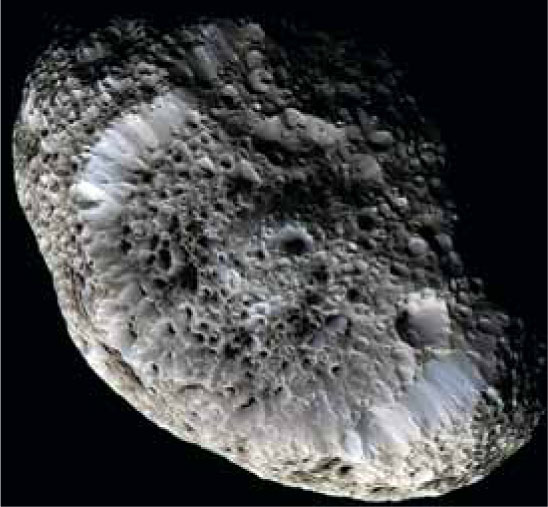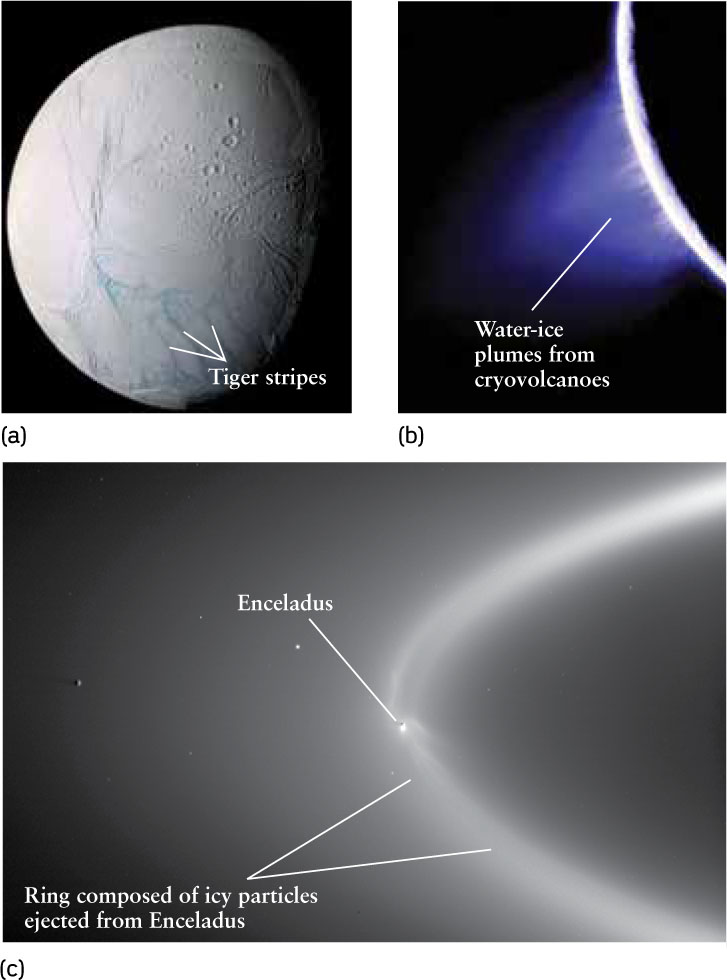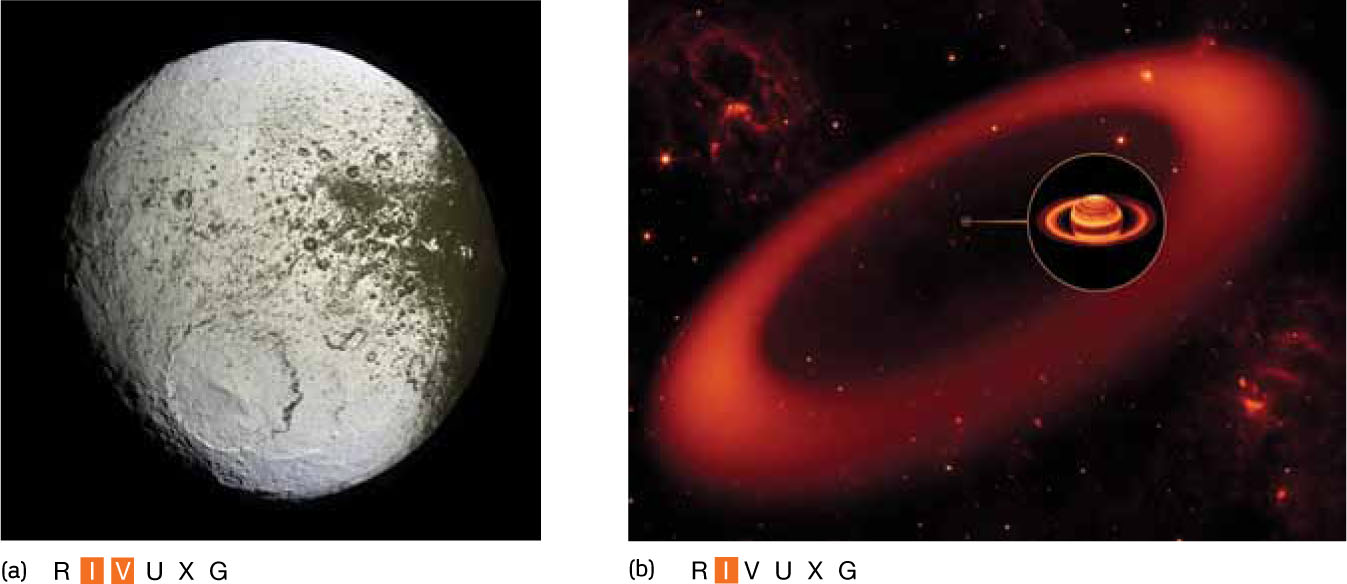13-10 The icy surfaces of Saturn’s six moderate-sized moons provide clues to their histories
Saturn, too, has an extensive collection of satellites: 62 are known as of 2012. As we do for Jupiter’s satellites in Section 13-9, we can subdivide the satellites of Saturn into three categories based on their sizes and their orbits. (Appendix 3 has information about the orbits of all of Saturn’s satellites.) We will see that while Saturn does not have a set of large moons like the Galilean satellites of Jupiter, it does have a remarkably diverse collection of moderate-sized satellites.
Saturn’s Retinue of Moons

Hyperion This heavily pockmarked moon is about 410 kilometers across its elongated axis. Its density is about half that of water, so it is probably very porous. Rather than rotating around a single axis, the gravitational tugs on its elongated body by Titan and Saturn lead to a non-repeating chaotic tumble.
One planet-sized satellite, Titan, is actually one of the terrestrial worlds of our solar system. With its diameter of 5150 km, Titan is intermediate in size between Mercury and Mars. Its prograde orbit has a semimajor axis of just over 20 times the radius of Saturn and lies in nearly the same plane as Saturn’s equator and rings.
 Six moderate-sized satellites were all discovered before 1800. These six satellites have properties and diameters that lead us to group them in pairs: Mimas and Enceladus (400 to 500 km in diameter), Tethys and Dione (roughly 1000 km in diameter), and Rhea and Iapetus (about 1500 km in diameter). The semimajor axes of their orbits range from 3.1 to 59 times the radius of Saturn. Like Titan, all of their orbits are prograde and close to the plane of Saturn’s equator.
Six moderate-sized satellites were all discovered before 1800. These six satellites have properties and diameters that lead us to group them in pairs: Mimas and Enceladus (400 to 500 km in diameter), Tethys and Dione (roughly 1000 km in diameter), and Rhea and Iapetus (about 1500 km in diameter). The semimajor axes of their orbits range from 3.1 to 59 times the radius of Saturn. Like Titan, all of their orbits are prograde and close to the plane of Saturn’s equator.
Fifty-five small satellites have sizes from 3 to 266 km. Some are in prograde orbits as small as 2.2 times the radius of Saturn, and lie within or close to the rings (see Figure 12-26). These satellites may be jagged fragments of ice and rock produced by impacts and collisions. The shepherd satellites that shape Saturn’s F ring (see Figure 12-25) may be such fragments. Others are in retrograde orbits with semimajor axes as large as 380 times Saturn’s radius and may be captured asteroids. A little farther out than Titan, Cassini made a close flyby of one strange moon named Hyperion (Figure 13-27).
CONCEPT CHECK 13-13
In Figure 13-27, Hyperion appears almost like a sponge on the outside. Why would we, in fact, expect a lot of empty space throughout Hyperion?
Six Strange Satellites
The most curious and mysterious of these worlds may be Saturn’s six moderate-sized satellites; four of these are shown in Figure 13-28. The six satellites have very low average densities of less than 1400 kg/m3. This implies that unlike the satellites of the inner solar system or the Galilean satellites of Jupiter, they are composed primarily of ices (mostly frozen water and ammonia) with very little rock. The motions of these mid-sized satellites are not surprising: All six orbit the planet in the plane of Saturn’s equator and in the direction of the planet’s rotation, and all six exhibit synchronous rotation. What is surprising is the curious variety of surface features that the Voyager and Cassini spacecraft discovered on these satellites.

Saturn’s Mid-Sized Satellites (a–d) These images from Cassini show the variety of surface features found on four of Saturn’s six moderate-sized satellites. The satellites depicted are not shown to scale.
372

Cryovolcanoes on Enceladus (a) This Cassini image reveals an icy Enceladus. The lack of significant cratering suggests that some geologic process resurfaced the moon within the past 100 million years. (b) Plumes of water vapor and ice are erupting from cryovolcanoes associated with the “tiger stripes” near the south pole of Enceladus. The faint plumes are best seen when they are backlit by the Sun, so Enceladus appears as a crescent. (c) A backlit view from Cassini shows how particles ejected from Enceladus become part of Saturn’s E ring, within which Enceladus orbits (see Figure 12-24).
Mimas, the innermost of the six middle-sized moons, has the heavily cratered surface we would expect on such a small world. Its most remarkable feature is a crater so large (Figure 13-28a) that the impact that formed it must have come close to shattering Mimas into fragments.
Most of Tethys, like Mimas, is heavily cratered. But Tethys also has an immense rift valley called Ithaca Chasma that extends for 2000 km, or about ¾ of the way around Tethys (Figure 13-28b). This rift may have formed when the water inside Tethys cooled and solidified, or it may be the result of a shock wave that traveled through Tethys after an immense asteroid impact. (A large impact crater lies at the antipode, which is on the side of Tethys opposite Ithaca Chasma.)
Dione, slightly larger than Tethys, has a strange surface dichotomy: The surfaces of its leading hemisphere (that is, the hemisphere facing toward its direction of orbital motion) and trailing hemisphere are quite different. Dione’s leading hemisphere is heavily cratered, but its trailing hemisphere is covered by a network of bright stress cracks caused by some sort of tectonic activity (Figure 13-28c). Like Dione, the moon Rhea also has more craters on its leading hemisphere (Figure 13-28d).
Enceladus has become one of the most interesting moons in the entire solar system (Figure 13-29). Cassini discovered that Enceladus is volcanically active, though with ice taking the place of lava. While the moon Titan shows evidence of ice-volcano formations (Figure 13-24), Cassini has caught the cryovolcanoes on Enceladus in the act of erupting! Figure 13-29b shows several distinct plumes ejecting water vapor and ice from the features referred to as “tiger stripes” near the satellite’s south pole. By measuring the distribution of speeds for water-ice particles ejected from Enceladus, high-speed ejecta were found that could escape Enceladus’s gravity to leave behind a ring in its orbit (Figure 13-29c). This is Saturn’s E ring (Figure 12-24) and solves a mystery about how this ring formed.
Although just 500 km across, Enceladus has powerful ice-volcanoes at its south pole
At first there was a major debate as to whether the ejected water came from a small patch of melted ice localized under the tiger stripes, or whether the water came from a global subsurface ocean. Cassini has shed light on this question when passing directly through the plumes and analyzing their content. By detecting dissolved minerals (or “salts”) within the water, Cassini data indicate that the water steadily dissolves a rocky mineral interior or mantle (just as Earth’s oceans do), which strongly supports the model of a large subsurface ocean.
With ocean water conveniently shot into space by Enceladus for our sampling and analysis, some scientists argue that Enceladus is the solar system’s best place to search for microbial life beyond Earth (in a future mission). Recall that Europa’s oceans are probably buried under 10 km of ice, making the liquid water very difficult to sample. We’ll consider this further in Chapter 27 (The Search for Extraterrestrial Life).
What could be powering the geologic activity on Enceladus? One guess is tidal heating, which provides the internal heat for the inner Galilean satellites of Jupiter (see Section 13-4). The satellite Dione orbits Saturn in 65.7 hours, almost exactly twice Enceladus’s orbital period of 32.9 hours, and the 1:2 ratio of orbital periods should set Enceladus up to be caught in a tidal tug-of-war between Saturn and Dione. Calculations suggest that the amount of tidal heating produced in this way is modest, but should be enough to melt the ices of Enceladus at least part of the time.
Another mysterious moon of Saturn, Iapetus, is also associated with a newly discovered ring of Saturn (Figure 13-30). Iapetus has been known to be unusual ever since its discovery in 1671: Unlike the other satellites, its brightness varies greatly as it orbits Saturn. Images from Cassini show extreme differences between the leading and trailing hemispheres of Iapetus (Figure 13-30a); the leading side faces in the direction of Iapetus’s orbit. Most of the leading hemisphere is as black as asphalt, but the trailing hemisphere is highly reflective, like the surfaces of the other moderate-sized moons.

373
What could account for the two-sided nature of Iapetus? Models for Iapetus suggest that a small initial difference in coloration between the two sides would be amplified. A slightly darker surface (less reflective) would absorb more sunlight, warm up more, and evaporate more ice. The residue left behind would leave the surface even darker and therefore warmer, amplifying the effect even further. In 2009, this idea gained support when a new ring of Saturn was discovered near to Iapetus that could provide the initial debris to start the runaway process of darkening (Figure 13-30b).
CONCEPT CHECK 13-14
Some early models to explain water ejected from Enceladus avoided reliance on a global subsurface ocean (although a large ocean is certainly the more exciting case), and instead considered smaller pockets of melted water. What subsequent data shifted models to a large ocean, and why?
374